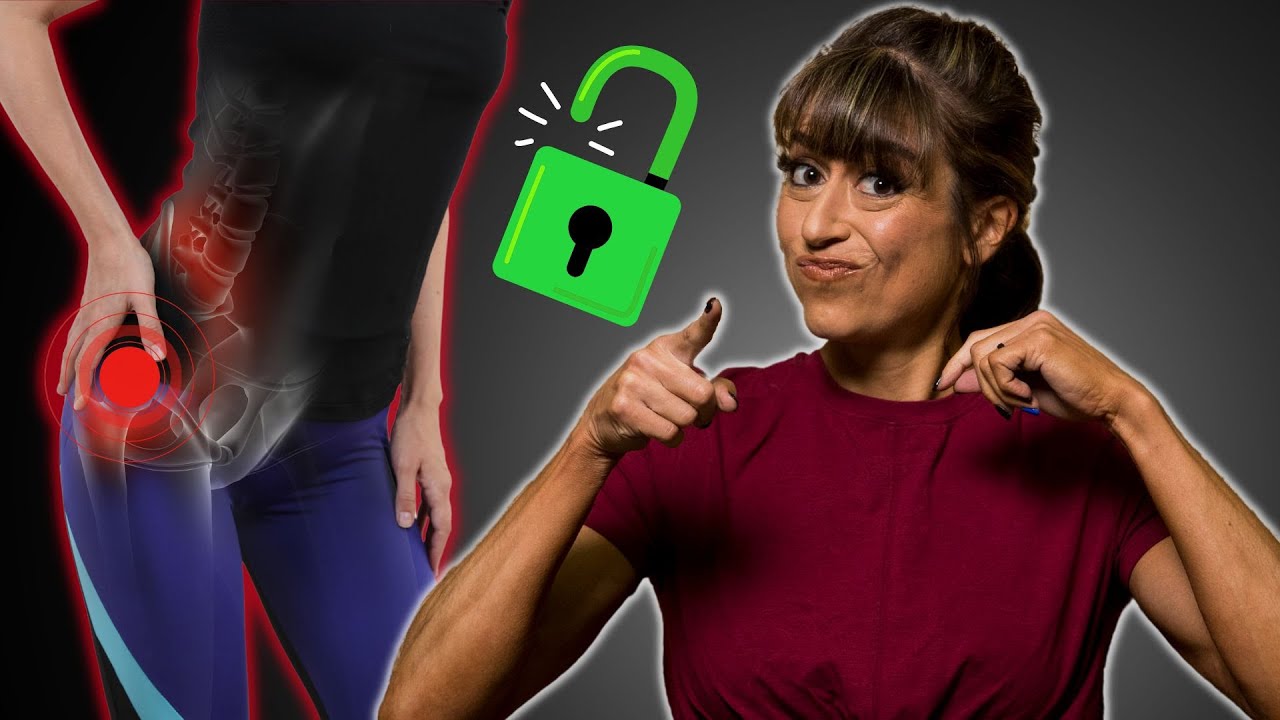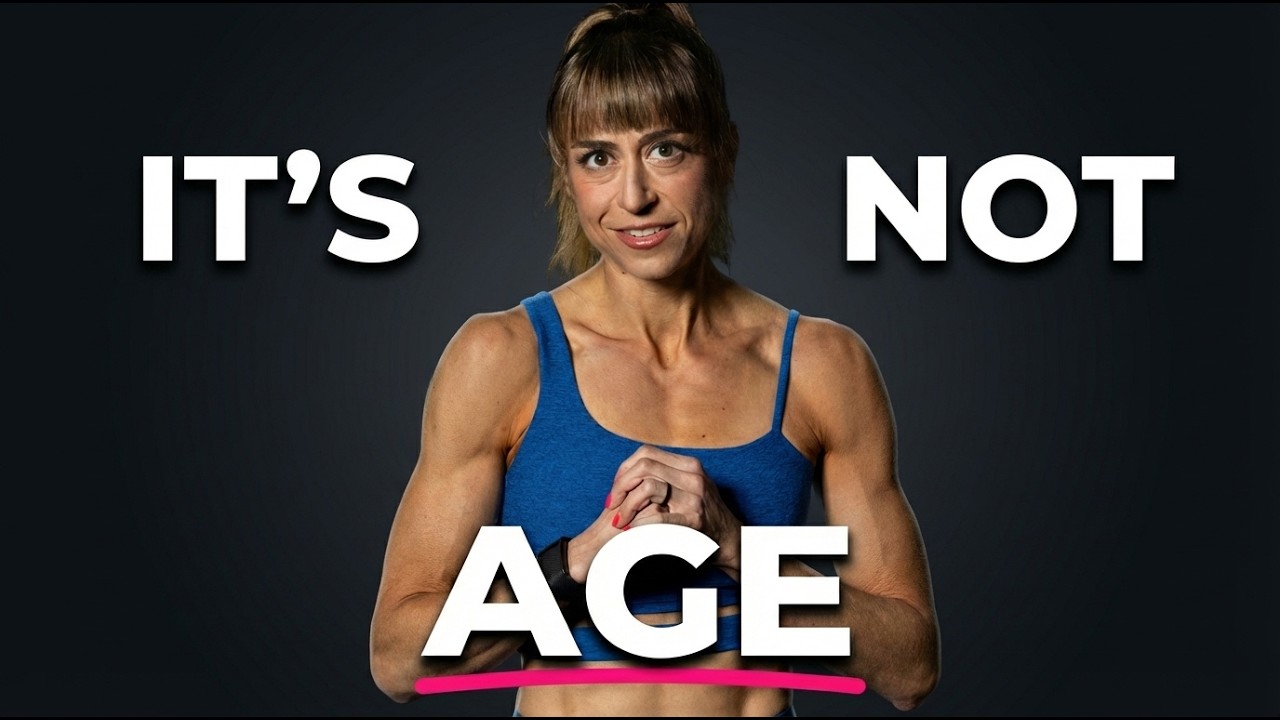Are you one of the many people out there struggling with tight hips or hip pain?
Whether it’s caused by a previous injury, sitting for long periods, or a sedentary lifestyle, hip pain and tight hips can be a major roadblock to your daily routine.
Rehab work can help improve our movements, BUT we have to KEEP doing it to see those results maintained.
Rehab must become prehab.
That’s why I want to share 6 moves to help you keep those hips, and even your lower back and knees, healthy and happy.
And at the end I’ll share a quick series you can do combining these moves to use daily!

Exercise #1: Rectus Femoris Foam Rolling
Especially if you spend a ton of time seated, you want to spend some time relaxing tight and overactive hip flexors.
One key hip flexor muscle to focus on is the rectus femoris. This quad muscle is the only one to impact both the knee and the hip so tightness can not only perpetuate your hip pain, but also your knee and even lower back aches and pains.
To roll out this muscle, a ball works best but will apply more pressure so if needed modify with a roller.
Lie face down with the ball in the middle front of your thigh. Relax over the ball, propping yourself up on your forearms.
Extend your leg out flexing that quad then relax. Repeat as you hold on the ball, breathing to help the muscle relax and release.
If you find you’re only tensing against the pressure, start with a softer trigger point tool.
Repeat for a few extensions then move the ball slightly up or down your thigh.
Exercise #2: Adductor Foam Rolling
Tightness of our adductors or inner thighs can perpetuate hip pain as well, causing hip alignment issues and even knee tracking issues.
If you find your knees tend to cave in and you struggle to feel your glute medius or side butt working, you may want to address any adductor tightness.
The adductors are also a hip flexor, so tightness there may be limiting your hip extension as well.
To roll out your adductors, a roller works best.
Place the roller to the side fo you and bend your knee to about 90 degrees placing the inside of your thigh by your knee on the roller. You can roll up toward your groin and work all along your inner thigh.
When you find a spot that is tight, lift your lower leg and then relax it back down and even push down into the roller then slightly release.
Don’t just roll up and down quickly but instead focus on holding on any tight spots to help the muscle relax and release.
Then you want to include stretching. If you are doing this as part of your warm up series, stretches that get your joints moving through a full range of motion is key.
Exercise #3: Bench Hip And Quad Stretch
This stretch will help improve your hip extension and stretch out any short and tight hip flexors. The key with this move is to focus on that back glute engaging to drive that back hip forward.
This stretch will isolate each side independently and really start to warm up your legs as well as it is basically a balance lunge!
To do this stretch, set up with a bench behind you. As long as your knee allows, set up at the bottom of the stretch kneeling on the ground. If you need to reduce the range of motion, put a block or even a pillow or cushion down on the ground to kneel on.
Place your back foot up on the bench and make sure your front foot is firmly pressed into the ground. Engage that back glute to help you kneel up nice and tall and drive your hip into extension from the bottom.
Then pressing off your front and back foot, lift up.
Squeeze that back glute the entire time and lower back down. Pause at the bottom on the ground for a breath and repeat.
If you find balancing a challenge, you can use a suspension trainer, chair or foam roller to hold on to just make sure you aren’t leaning forward but instead staying upright.
Leaning forward would put your hip back into flexion!
Exercise #4: Alternating Pigeon Pose
The pigeon pose stretch is an amazing stretch to improve your hip mobility, especially if you’ve ever had sciatic pain, lower back pain or even IT band and knee issues.
However, the static version isn’t a great way to warm up your body for work.
With this variation, moving through that range of motion, you can implement this stretch while really mobilizing those hips.
To do this stretch, start on your hands and knees. Then begin to walk your hands to one sides on the ground as you swing the leg on the side you’re walking toward back behind you and across your other leg.
Your body will rotate as you move into that pigeon pose, sitting into the glute of that front leg with your shin perpendicular to your body. Flex your foot if you do feel any pressure in that front knee.
Focus on squaring your hips up toward the ground as much as possible as you reach that one leg straight back. Engage that back glute to drive that back hip into extension as you feel the outside of your front glute stretching.
Pause for a breath then move back onto your hands and knees before rotating into pigeon on the other side.
If this feels like too much, or you can’t put pressure on your knees, try a seated bench variation, alternating pigeon pose on each side, pressing the knee gentle open as you hinge forward and sit back up before switching sides.
Next you want to include focused activation exercises.
While with the stretching you want to focus on what you feel even working to drive the stretch and begin that activation process, these moves are really key to get those underactive muscles working and improve your hip and even pelvic stability.
This first activation exercise focuses on activating those glutes.
Exercise #5: The Wall Side Lying Lateral Raise
Too often, especially if we’ve had previous lower back, hip or knee injuries, our glutes aren’t working as effectively as they should be and we need to work to improve that mind-body connection.
Isolation moves like this to create a slight pump and burn, but not fatigue the muscle, prior to our training are key.
The Wall Side Lying Lateral Raise is an amazing glute activation move to include because it targets both the glute medius and glute max to improve your hip stability.
The one thing we have to remember is the “right” moves only benefit us if the correct muscles are working.
And often we will allow our TFL or piriformis to compensate during lateral raise movements.
That’s why this variation of the lateral raise is so helpful.
Turning your toe down toward the ground even just slightly vs letting it rotate open can really help you avoid that hip flexor or piriformis from taking over and the slight kick back helps also engage your glute max and avoid any hip flexor engagement to better activate that glute medius.
To do this exercise, set up lying on your side with the bottom leg bent and your butt a few inches from the wall.
You can fully lie on your side with your bottom arm straight out on the ground or you can prop yourself up to rest your head in your hand.
Lift your top leg up a few inches off your bottom leg and even slightly turn that top toe down toward the ground.
Drive your heel back into the wall behind you and feel your glute engage pushing into the wall.
Slide your heel up the wall lifting your leg and focus on the side of your butt lifting as you drive hard back into the wall.
Do not let your body rotate or your toe turn open just to try to lift higher.
Perform this lateral raise but do not rotate your hip open to raise up higher.
To advance this move, add a mini band around your legs above your knee.
The final exercise in this series will work on pelvic stability, engaging your core, glutes and even your hamstrings.
Exercise #6: Is Alternating Pelvic Tilt Leg Glides
Often our hamstrings feel tight and we turn to stretching.
But in many cases they are weak.
And even being weak they may want to take over for underactive glutes.
That’s why exercises like this that work on core bracing as you strengthen your hamstrings can help improve your hip stability while also helping you avoid hamstring strains and injuries!
To do this move, lie on your back with a slider or towel under each heel and your heels a few inches from your butt. Feel the space between your lower back and the ground.
Engage your abs to get rid of the space as you press your lower back into the ground. Taking a deep breath and then exhaling as you draw your hip bones up toward your ribs can help you engage those abs.
Keeping your abs engaged, slowly slide one heel out, straightening your leg out.
Then curl that heel back in, pulling the heel in with your hamstring almost as if you are trying to drive the slider into the ground as you curl it back in.
Feel your hamstring work to pull it back in and avoid your pelvis shifting.
Move slowly and alternate sides, extending the other leg out.
If you feel your hips shifting, stay on one side versus alternating.
Really focus on feeling your hamstring with that pull back in. Drive your heel down hard into that sliders to engage it and even your glute.
If you don’t create that tension you won’t get the benefit of this move.
To combine these 6 moves, try this series below.
I like using intervals as it really allows us to focus on maximizing the movement over counting reps. While you can do each move up to 1 minute per move or side, even 30 seconds is a great place to start!
CIRCUIT:
30-60 seconds per side Rectus Femoris Foam Rolling
30-60 seconds per side Adductor Foam Rolling
30-60 seconds per side Bench Hip And Quad Stretch
30-60 seconds Alternating Pigeon Pose
30-60 seconds per side The Wall Side Lying Lateral Raise
30-60 seconds Alternating Pelvic Tilt Leg Glides
Ready to improve your mobility EVERYWHERE?!
Check out my RStoration!



0 Comments